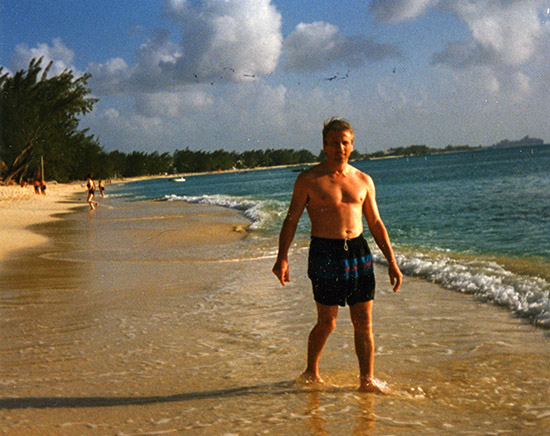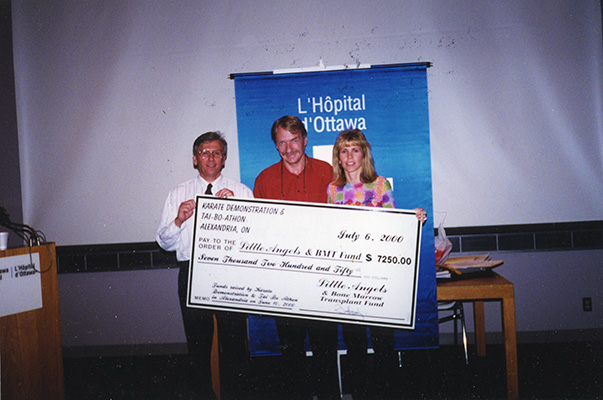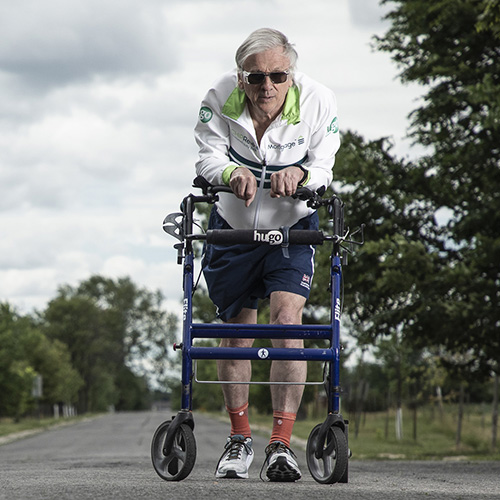Robert (Bob) Hardy has been in a fight for his life for more than 20 years. From a bone marrow transplant for leukemia, to a blood clot in his intestine and his neck, it seems nothing can slow him down. In fact, thanks to lifesaving care at The Ottawa Hospital, he’s stronger than ever and unwavering in his desire to compete in some of the most renowned marathons around the world — with his walker. Beating his personal best time, year after year, you wouldn’t suspect that this ‘Walker-Runner’ initially had only a 40% chance of survival.
A startling diagnosis
There was a time many years ago when Bob believed he only had six months to live. Feeling slightly fatigued, but healthy overall, he went for a routine physical. When his examination results returned, Bob received startling news. At only 46 years old, and long before experiencing any side effects of the disease, he was diagnosed with leukemia. Bob and his wife, Vittorina, were stunned. All they could think about was how they would tell their two young girls, Shannon and Leah, who at the time were only 13 and nine. “It was a really big shock for all of us. The thought of having to tell our children wasn’t easy, but it wasn’t something I was willing to hide from them either,” said Bob.
But if you’re looking for a woe-is-me attitude, you won’t get it from Bob. Even a diagnosis of this magnitude couldn’t bring him down. “When I told my youngest daughter, Leah, about my diagnosis,” said Bob, “she told me ‘you’re too strong to die, dad.’” That was the encouragement Bob needed to hear. It was her words that motivated him to fight back and beat the disease.

A fight for his life
Up until Bob’s leukemia diagnosis he was studying jiu-jitsu – and fit as ever. But while he waited for a match donor for a bone marrow transplant, the medication, interferon, that doctors prescribed to maintain his health was making him weak. Bob was struggling to continue with his training. “I wanted to get my black belt before undergoing my bone marrow transplant,” expressed Bob. He felt a black belt would give him the confidence he needed to begin the long road to healing and recovery. Knowing just how much this milestone would mean to Bob, his doctors allowed him to temporarily discontinue taking interferon for two months prior to Bob’s black belt test, so that he could continue training for the big day. And when that day came, he got his black belt – with honours. It was only then that he felt ready for his bone marrow transplant and the ups and downs that would follow.
A perfect match
After a year of taking interferon, a six-antigen match donor for the bone marrow transplant was found. At the time, performing a bone marrow transplant using an unrelated donor was still relatively new. But researchers discovered that patients can have a match donor outside of their family. “It isn’t common for two people to have the same set of six antigens if they aren’t blood related. I was lucky. They found a perfect match,” explained Bob. More recently, however, advances in research have allowed our experts to perform a transplant using an incompatible donor, significantly reducing the time patients must wait for a match donor. “What this means is that, where once many did not have a donor, now almost everyone has one,” explained Dr. Huebsch. “This research is truly groundbreaking.”

With a donor ready to help, the pre-transplant treatment of high doses of chemotherapy and radiation to suppress Bob’s immune system began. Four weeks later, his immune system was primed to receive the bone marrow transplant. He underwent this procedure at The Ottawa Hospital, and remained in our care for three weeks to ensure the transplanted healthy cells were multiplying – and they were.
Bone marrow is the soft, fatty tissue inside your bones, which produces blood cells. A transplant, inserted into the blood stream through a catheter, replaces the unhealthy blood forming cells (stem cells) with healthy ones.
Although doctors wanted Bob to remain in hospital for a few weeks post treatment, he was able to go home for the majority of his recovery. In fact, Bob benefited from our innovative outpatient bone marrow transplant program that has allowed thousands of patients to be treated and recover more conveniently from home. This program was one of the first in Canada and, since its inception, our patients have been surrounded by loved ones throughout recovery.
Thrombosis expertise in Ottawa
Over the course of the next two years, Bob was in and out of the hospital. “The first two years were the hardest. I had a lot of side effects from my treatment,” said Bob. One of the most severe side effects Bob experienced was blood clotting. The first to appear was in his stomach and a second in his neck. Cancer patients are often at greater risk of blood clotting as chemotherapy is hard on the veins. Approximately one in every twenty cancer patients will experience blood clotting – often a life-threatening complication. But Bob was in good hands. He benefited from the development of a tool to help diagnose blood clots quickly, known as the Wells Rule, after Dr. Phil Wells, an expert at The Ottawa Hospital. This tool is now used in emergency rooms and taught in medical schools around the world.
“We have one of the best thrombosis departments in Canada, attracting experts in the field from across the globe.” – Dr. Marc Carrier
Researchers have since implemented a comprehensive program for managing blood-thinning medications for patients at higher risk of developing blood clots, including cancer patients like Bob. This program has ensured that patients at our hospital are more likely to have optimal blood thickness, and less likely to develop blood clots.
More recently, our experts have developed a system to identify the likelihood that a cancer patient will develop blood clots. Although this was not yet available at the time of Bob’s diagnosis, this innovative tool can classify newly diagnosed cancer patients as being at greater risk and they can receive personalized care based on their unique circumstance to prevent blood clotting. “We have one of the best thrombosis departments in Canada, attracting experts in the field from across the globe,” said Dr. Carrier, Chief, Division of Hematology. “Our highly specialized and dedicated researchers are developing groundbreaking procedures that demonstrate our commitment to continuously moving research and treatments forward, so that we can continue to provide exceptional care to each patient that walks through our doors,” said Dr. Carrier.
World-class care in Hematology
Throughout Bob’s treatment, he was cared for through The Ottawa Hospital Hematology and Thrombosis Program, one of the best and largest in Canada. Unlike many other hospitals, where patients must travel to different hospital departments and satellite locations to receive treatment, our unique program provides centralized care for patients with diseases of the lymph glands, blood, and bone marrow for patients across eastern Ontario and beyond.
“We are among the best. Ottawa is at the centre of all sorts of blood transfusion medicine and we’re one of the leading centers in the world for doing, and researching, transplantation for life threatening diseases.” – Dr. Lothar Huebsch

The program, which has attracted leading researchers from around the world, is renowned for the development and advancement of world-first procedures that are changing lives. “We are among the best,” explained Dr. Huebsch, Clinical Hematologist and former head of hematologic oncology. “Ottawa is at the centre of all sorts of blood transfusion medicine and we’re one of the first in the world to successfully perform transplantations for life threatening diseases.” Our Hematology and Thrombosis Program has led the way for decades, researching transplant techniques with other illnesses such as multiple sclerosis, autoimmune diseases, and lymphoma. “This is the kind of research we’ve done for 25 years, and we are one of the leading centers in the world for doing these transplants in the outpatient setting, rather than in a high intensity ward as an impatient,” said Dr. Huebsch.
Road to recovery inspires ‘walker-running’

With so much time spent in and out of hospital throughout his treatment, Bob needed something to do to keep himself busy while he recovered. So, he got creative. “A few of us used to take our IV polls and race them down the hallways. The nurses couldn’t believe how fast we were moving!” What Bob didn’t realize at the time was racing IV polls would later spark aspirations to participate in some of the most renowned marathons.
Following treatment for the blood clot in his neck, Bob lost his sense of balance. Although he can walk short distances without an aid, he’s unable to run or walk long distance. That’s when Vittorina suggested he get a walker. “At first, I was hesitant about using a walker, but then I realized how fast I could move!” said Bob. And so began his passion for ‘walker-running’.
Bob started his walker-running career participating in the Wobbly Walker-Walk-a-thon, but soon shifted into high gear signing up as a marathoner in Run for a Reason at Tamarack Ottawa Race Weekend. His marathons not only accomplished a personal goal, but also raised funds in support of The Ottawa Hospital.
A new appreciation for life
Bob’s road to recovery hasn’t been an easy one, but there hasn’t been a day he’s felt sorry for himself. Over the years he started to get stronger and complications were fewer and far between. “I am so thankful for the treatment I received. The nurses and my doctors were outstanding – absolutely incredible,” said Bob. “I’m here today, pursuing my passion for walker-runner marathons, because of them. They saved my life.”
Of course, there are still some days that Bob feels more run down than others. On those days he tries to take a walk to reminisce on how far he’s come in his recovery. “I know what it takes to get over things and to get through things. Not only did I have the very best care at The Ottawa Hospital, I had something to live for. I was able to watch my girls grow up. And now, here I am at age 69, almost 70, I’ve overcome countless obstacles and have jumped over hurdles, and I’m really quite happy with my life. I’m really very happy.”
“I am so thankful for the treatment I received. The nurses and my doctors were outstanding – absolutely incredible.” – Bob Hardy
The Ottawa Hospital is a leading academic health, research, and learning hospital proudly affiliated with the University of Ottawa.




